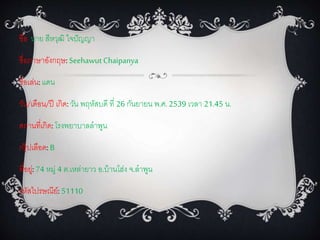1 of 6
Download to read offline






Ad
Recommended
An Introduction To Docker
An Introduction To DockerJames fraser
��
Docker is a container platform that allows applications to be packaged with all their dependencies and run in isolated containers on any infrastructure. Containers share the host operating system kernel and are more lightweight than virtual machines. Docker uses images to package applications and containers to run the packaged application. Images are read-only templates used to build containers which are where the application runs. Docker provides tools for building, shipping and running applications in containers.Jak zakodzić i się nie narobić a nawet zarobić na tworzeniu oprogramowania?
Jak zakodzić i się nie narobić a nawet zarobić na tworzeniu oprogramowania?3camp
��
Jakub Dąbkowski - DeSmart - Jak zakodzić i się nie narobić a nawet zarobić na tworzeniu oprogramowania?Delighting mobile customers with content for apps, videos, and a social media...
Delighting mobile customers with content for apps, videos, and a social media...Marta Rauch
��
The document outlines strategies for creating effective mobile content, including app descriptions, videos, and social media campaigns for engaging customers. It emphasizes the importance of feedback and adapting content for various platforms to enhance user experience and engagement. Additionally, it highlights the significance of analyzing user metrics and communicating successes to gain support for future projects.Mule velocity
Mule velocityPraneethchampion
��
Mule can be used to send emails with dynamically generated content using Velocity templates. Velocity templates allow using HTML tags to design colorful email bodies with images, logos, and dynamic text values pulled from property files. The example shows how to create a Velocity transformer class to set the email payload and map external values, use a properties file to define dynamic values, and write a Velocity template integrating the HTML tags, dynamic values, and file content into the email body. Testing confirms Mule successfully sends the email with the customized Velocity template design.Gagan (13) assignment_2_mo_s
Gagan (13) assignment_2_mo_sGagan Pradeep
��
This document contains a student's assignment submission for a course on management of services. The assignment discusses various customer service experiences and expectations. It includes exercises analyzing service quality, recovery experiences, and survey design for a new service. The submission demonstrates an understanding of key customer service concepts like desired vs adequate expectations, service intensifiers, and the five dimensions of service quality.No pressure, no diamonds. Rzecz o łamaniu zasad w projektach.
No pressure, no diamonds. Rzecz o łamaniu zasad w projektach.3camp
��
Daniel Aduszkiewicz – UXPin – No pressure, no diamonds. Rzecz o łamaniu zasad w projektach.Reactive programming at scale
Reactive programming at scale John McClean
��
The document discusses the principles and practices of reactive programming at scale, focusing on its implementation in data processing, specifically in advertising technology. It highlights the advantages of functional reactive programming, such as improved parallelization and reduced bugs, along with examples of reactive pipelines. Additionally, it outlines system requirements and performance differences to address challenges in concurrency and data responsiveness.Jenkins Best Practices
Jenkins Best PracticesGergely Brautigam
��
This document discusses Jenkins best practices, including using plugins to simplify the UI, manage configuration history, rebuild jobs, and mask passwords. It also covers using folders to organize jobs by branch, the job DSL plugin to define jobs programmatically, and artifact repositories to share artifacts between Jenkins instances. More advanced topics include using the multijob plugin for parallel test runs, the pretested integration plugin for branch setup, and integrating pipelines in Jenkins 2.0. The document concludes with bonus techniques like provisioning build slaves with Packer/Vagrant/Docker and load balancing Jenkins slaves.Owning Web Performance with PhantomJS 2 - Fluent 2016
Owning Web Performance with PhantomJS 2 - Fluent 2016Wesley Hales
��
The document discusses web performance measurement, emphasizing the importance of understanding when a webpage fully loads for user experience. It introduces the Navigation Timing API as a foundational tool for assessing performance metrics and highlights the capabilities of PhantomJS 2 for executing performance tests. The document also mentions synthetic Real User Monitoring (RUM) techniques and relevant APIs for enhanced performance analysis.PostgreSQL и JDBC: выжимаем все соки
PostgreSQL и JDBC: выжимаем все сокиVladimir Sitnikov
��
Документ представляет собой презентацию Владимира Ситникова на PGConf 2016, посвященную работе с PostgreSQL и JDBC. В ней обсуждаются аспекты производительности, такие как выборка и вставка данных, использование подготовленных выражений и сетевых протоколов. Также рассматриваются проблемы, возникающие при динамическом создании запросов и лучших практиках для оптимизации обработки данных.New Security Framework in Apache Geode
New Security Framework in Apache GeodePivotalOpenSourceHub
��
The document discusses Apache Geode, a data management platform that provides tools for managing clusters and data, including authentication and authorization processes. It describes the implementation of a security manager for user authentication and permission mapping, along with the use of Apache Shiro for enhanced security features. Finally, it outlines the future of Geode security, including custom realms and various authentication methods.Введение в performance management
Введение в performance managementSQALab
��
Документ представляет собой материал конференции по качеству программного обеспечения, где обсуждаются методы и практики performance management. Основное внимание уделено вопросам проведения performance-тестирования, создания отчетов, а также формулировке и соблюдению бизнес-требований (NFR). Представлены примеры сценариев, метрик и ожидаемых нагрузок, а также детали, касающиеся подготовки тестовой среды и необходимых ресурсов.Leveraging your hadoop cluster better - running performant code at scale
Leveraging your hadoop cluster better - running performant code at scaleMichael Kopp
��
The document discusses optimizing Hadoop clusters for better efficiency by identifying and resolving bottlenecks and resource utilization issues. It emphasizes the importance of measuring efficiency through output to input ratios and the potential for significant performance improvements through small fixes. Key strategies include using hotspot analysis tools, understanding job bottlenecks, and optimizing resources to reduce wait times and increase overall cluster performance.Designing rest with raml part2
Designing rest with raml part2Anirban Sen Chowdhary
��
This presentation describe the creation of RESTful api using RAML and by using various RAML specsIntroduction to Shield and kibana
Introduction to Shield and kibanaKnoldus Inc.
��
The document provides an overview of Shield, a security plugin for Elasticsearch, and Kibana, an analytics and visualization platform. It details installation processes, user authentication, role management, and advanced security features like message authentication and SSL/TLS encryption. Additionally, it covers how to use Kibana with Shield, including user roles and dynamic mapping for creating visualizations.Building a testing team
Building a testing teamSQALab
��
This document outlines the process of building a new software testing team from scratch within a short timeframe. Key steps included defining team roles and hiring internal resources, setting up infrastructure and providing extensive training on testing processes, tools, and the software architecture. Training occurred both through classroom sessions and shadowing existing testing teams. The team focused on writing test cases, reviewing each other's work, and learning through hands-on testing and feedback. After 5 weeks of preparation, the new team was able to successfully test and go live with the new software on time and on budget, though quality could still be improved. Management support and extensive training of new testers were essential to the team's success.Augmented Reality and Google Glass
Augmented Reality and Google GlassMarta Rauch
��
The document discusses the significance of augmented reality (AR) and Google Glass, highlighting its applications across various fields such as publishing, automotive, and education. It outlines the features, user experience, and enterprise use cases of AR technologies, emphasizing their growing impact and potential revenue growth. Additionally, it provides resources and examples of current AR applications compatible with Google Glass.Развитие процессов тестирования в Badoo за три года
Развитие процессов тестирования в Badoo за три годаSQALab
��
Документ описывает эволюцию процессов тестирования в компании Badoo за три года, начиная с числа тестов и релизов, увеличившихся до 55,000 тестов и 2-3 минут на их прохождение. Приведены разные этапы контроля качества, включая автоматизированное и ручное тестирование, а также инструменты и методы, используемые для их оптимизации. Основное внимание уделяется значению тестирования на каждом этапе разработки и мониторингу верификации на продакшне.CI and CD at Scale: Scaling Jenkins with Docker and Apache Mesos
CI and CD at Scale: Scaling Jenkins with Docker and Apache MesosCarlos Sanchez
��
The document discusses strategies for scaling Jenkins using Docker and Apache Mesos, detailing the pros and cons of increasing build agents versus masters. It outlines a complex architecture including a cluster of 2000 Jenkins masters and dynamic build agent creation, emphasizing the need for fault tolerance and optimal resource management. Additionally, it covers technical considerations regarding networking, container management, resource limits, and the use of Terraform for automation in AWS and OpenStack environments.More Related Content
Viewers also liked (20)
An Introduction To Docker
An Introduction To DockerJames fraser
��
Docker is a container platform that allows applications to be packaged with all their dependencies and run in isolated containers on any infrastructure. Containers share the host operating system kernel and are more lightweight than virtual machines. Docker uses images to package applications and containers to run the packaged application. Images are read-only templates used to build containers which are where the application runs. Docker provides tools for building, shipping and running applications in containers.Jak zakodzić i się nie narobić a nawet zarobić na tworzeniu oprogramowania?
Jak zakodzić i się nie narobić a nawet zarobić na tworzeniu oprogramowania?3camp
��
Jakub Dąbkowski - DeSmart - Jak zakodzić i się nie narobić a nawet zarobić na tworzeniu oprogramowania?Delighting mobile customers with content for apps, videos, and a social media...
Delighting mobile customers with content for apps, videos, and a social media...Marta Rauch
��
The document outlines strategies for creating effective mobile content, including app descriptions, videos, and social media campaigns for engaging customers. It emphasizes the importance of feedback and adapting content for various platforms to enhance user experience and engagement. Additionally, it highlights the significance of analyzing user metrics and communicating successes to gain support for future projects.Mule velocity
Mule velocityPraneethchampion
��
Mule can be used to send emails with dynamically generated content using Velocity templates. Velocity templates allow using HTML tags to design colorful email bodies with images, logos, and dynamic text values pulled from property files. The example shows how to create a Velocity transformer class to set the email payload and map external values, use a properties file to define dynamic values, and write a Velocity template integrating the HTML tags, dynamic values, and file content into the email body. Testing confirms Mule successfully sends the email with the customized Velocity template design.Gagan (13) assignment_2_mo_s
Gagan (13) assignment_2_mo_sGagan Pradeep
��
This document contains a student's assignment submission for a course on management of services. The assignment discusses various customer service experiences and expectations. It includes exercises analyzing service quality, recovery experiences, and survey design for a new service. The submission demonstrates an understanding of key customer service concepts like desired vs adequate expectations, service intensifiers, and the five dimensions of service quality.No pressure, no diamonds. Rzecz o łamaniu zasad w projektach.
No pressure, no diamonds. Rzecz o łamaniu zasad w projektach.3camp
��
Daniel Aduszkiewicz – UXPin – No pressure, no diamonds. Rzecz o łamaniu zasad w projektach.Reactive programming at scale
Reactive programming at scale John McClean
��
The document discusses the principles and practices of reactive programming at scale, focusing on its implementation in data processing, specifically in advertising technology. It highlights the advantages of functional reactive programming, such as improved parallelization and reduced bugs, along with examples of reactive pipelines. Additionally, it outlines system requirements and performance differences to address challenges in concurrency and data responsiveness.Jenkins Best Practices
Jenkins Best PracticesGergely Brautigam
��
This document discusses Jenkins best practices, including using plugins to simplify the UI, manage configuration history, rebuild jobs, and mask passwords. It also covers using folders to organize jobs by branch, the job DSL plugin to define jobs programmatically, and artifact repositories to share artifacts between Jenkins instances. More advanced topics include using the multijob plugin for parallel test runs, the pretested integration plugin for branch setup, and integrating pipelines in Jenkins 2.0. The document concludes with bonus techniques like provisioning build slaves with Packer/Vagrant/Docker and load balancing Jenkins slaves.Owning Web Performance with PhantomJS 2 - Fluent 2016
Owning Web Performance with PhantomJS 2 - Fluent 2016Wesley Hales
��
The document discusses web performance measurement, emphasizing the importance of understanding when a webpage fully loads for user experience. It introduces the Navigation Timing API as a foundational tool for assessing performance metrics and highlights the capabilities of PhantomJS 2 for executing performance tests. The document also mentions synthetic Real User Monitoring (RUM) techniques and relevant APIs for enhanced performance analysis.PostgreSQL и JDBC: выжимаем все соки
PostgreSQL и JDBC: выжимаем все сокиVladimir Sitnikov
��
Документ представляет собой презентацию Владимира Ситникова на PGConf 2016, посвященную работе с PostgreSQL и JDBC. В ней обсуждаются аспекты производительности, такие как выборка и вставка данных, использование подготовленных выражений и сетевых протоколов. Также рассматриваются проблемы, возникающие при динамическом создании запросов и лучших практиках для оптимизации обработки данных.New Security Framework in Apache Geode
New Security Framework in Apache GeodePivotalOpenSourceHub
��
The document discusses Apache Geode, a data management platform that provides tools for managing clusters and data, including authentication and authorization processes. It describes the implementation of a security manager for user authentication and permission mapping, along with the use of Apache Shiro for enhanced security features. Finally, it outlines the future of Geode security, including custom realms and various authentication methods.Введение в performance management
Введение в performance managementSQALab
��
Документ представляет собой материал конференции по качеству программного обеспечения, где обсуждаются методы и практики performance management. Основное внимание уделено вопросам проведения performance-тестирования, создания отчетов, а также формулировке и соблюдению бизнес-требований (NFR). Представлены примеры сценариев, метрик и ожидаемых нагрузок, а также детали, касающиеся подготовки тестовой среды и необходимых ресурсов.Leveraging your hadoop cluster better - running performant code at scale
Leveraging your hadoop cluster better - running performant code at scaleMichael Kopp
��
The document discusses optimizing Hadoop clusters for better efficiency by identifying and resolving bottlenecks and resource utilization issues. It emphasizes the importance of measuring efficiency through output to input ratios and the potential for significant performance improvements through small fixes. Key strategies include using hotspot analysis tools, understanding job bottlenecks, and optimizing resources to reduce wait times and increase overall cluster performance.Designing rest with raml part2
Designing rest with raml part2Anirban Sen Chowdhary
��
This presentation describe the creation of RESTful api using RAML and by using various RAML specsIntroduction to Shield and kibana
Introduction to Shield and kibanaKnoldus Inc.
��
The document provides an overview of Shield, a security plugin for Elasticsearch, and Kibana, an analytics and visualization platform. It details installation processes, user authentication, role management, and advanced security features like message authentication and SSL/TLS encryption. Additionally, it covers how to use Kibana with Shield, including user roles and dynamic mapping for creating visualizations.Building a testing team
Building a testing teamSQALab
��
This document outlines the process of building a new software testing team from scratch within a short timeframe. Key steps included defining team roles and hiring internal resources, setting up infrastructure and providing extensive training on testing processes, tools, and the software architecture. Training occurred both through classroom sessions and shadowing existing testing teams. The team focused on writing test cases, reviewing each other's work, and learning through hands-on testing and feedback. After 5 weeks of preparation, the new team was able to successfully test and go live with the new software on time and on budget, though quality could still be improved. Management support and extensive training of new testers were essential to the team's success.Augmented Reality and Google Glass
Augmented Reality and Google GlassMarta Rauch
��
The document discusses the significance of augmented reality (AR) and Google Glass, highlighting its applications across various fields such as publishing, automotive, and education. It outlines the features, user experience, and enterprise use cases of AR technologies, emphasizing their growing impact and potential revenue growth. Additionally, it provides resources and examples of current AR applications compatible with Google Glass.Развитие процессов тестирования в Badoo за три года
Развитие процессов тестирования в Badoo за три годаSQALab
��
Документ описывает эволюцию процессов тестирования в компании Badoo за три года, начиная с числа тестов и релизов, увеличившихся до 55,000 тестов и 2-3 минут на их прохождение. Приведены разные этапы контроля качества, включая автоматизированное и ручное тестирование, а также инструменты и методы, используемые для их оптимизации. Основное внимание уделяется значению тестирования на каждом этапе разработки и мониторингу верификации на продакшне.CI and CD at Scale: Scaling Jenkins with Docker and Apache Mesos
CI and CD at Scale: Scaling Jenkins with Docker and Apache MesosCarlos Sanchez
��
The document discusses strategies for scaling Jenkins using Docker and Apache Mesos, detailing the pros and cons of increasing build agents versus masters. It outlines a complex architecture including a cluster of 2000 Jenkins masters and dynamic build agent creation, emphasizing the need for fault tolerance and optimal resource management. Additionally, it covers technical considerations regarding networking, container management, resource limits, and the use of Terraform for automation in AWS and OpenStack environments.Similar to ประวัติส่ว�Ȩ��ัว (20)
Ad
ประวัติส่ว�Ȩ��ัว
- 2. ชื่อ: นาย สีหวุฒิ ใจปัญญา ชื่อภาษาอังกฤษ: Seehawut Chaipanya ชื่อเล่น: แดน วัน/เดือน/ปี เกิด: วัน พฤหัสบดี ที่ 26 กันยายน พ.ศ. 2539 เวลา 21.45 น. สถานที่เกิด: โรงพยาบาลลาพูน กรุ๊ปเลือด: B ที่อยู่: 74 หมู่ 4 ต.เหล่ายาว อ.บ้านโฮ่ง จ.ลาพูน รหัสไปรษณีย์: 51110
- 3. บิดาชื่อ: นาย วินัย ใจปัญญา อาชีพ: ชาวสวน มารดาชื่อ: นาง สุรีย์ ใจปัญญา อาชีพ: แม่บ้าน
- 4. อาหารที่ชอบ: ขนมจีนนา้เงีย้ว สัตว์เลยี้งที่ชอบ: แมว กิจกรรมยามว่าง: ฟังเพลง อ่านการ์ตูน นอนหลับ ศิลปินที่ชอบ: โลโซ Line: Din Dan Neverdie Facebook: https://www.facebook.com/HLL.RAWEISUDA/photos
- 5. ประวัติการศึกษา ระดับประถมศึกษา: โรงเรียนจิรพิทยา โรงเรียนบ้านหล่ายท่า ระดับมัธยมต้น: โรงเรียนเฉลิมพระเกียรติสมเด็จพระศรีนครินทร์ พะเยา โรงเรียนพะเยาพิทยาคม ระดับมัธยมปลาย: โรงเรียนยุพราชวิทยาลัย ปัจจุบันกาลังศึกษาระดับชัน้มัธยมศึกษาปีที่ 6 โรงเรียนยุพราชวิทยาลัย